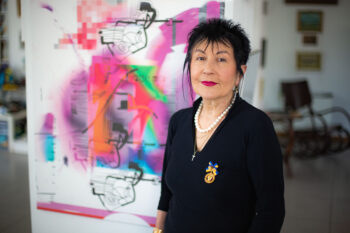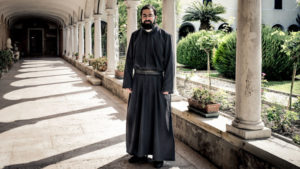SAN LAZZARO, Italy (Financial Times) — In the middle of the Venetian lagoon, near the Lido, lies a remarkable island that escapes the radar of checklist tourists. It is an oasis of calm and spacious gardens, fragrant with pine, roses and the residual trail of incense. In the silence, you hear birdsong, the thrice daily tolling of bells and the plangent echo of Armenian chants. For an hour or so each day, you will also hear a guide showing a small group the treasures and achievements of this place, which have been admired by luminaries including Pope Pius VII, Lord Byron, George Sand and Richard Wagner. If you are lucky, that guide might be Father Hamazasp Kechichian, one of just 17 souls living on the island in buildings dating from the 18th century.
The island, San Lazzaro degli Armeni, has been home to a community of Mekhitarist monks — Armenian Catholics who follow the Armenian rite and liturgy — since a monastery was founded on the former leper colony by the eponymous Abbot Mekhitar in 1717. For Kechichian, the tranquillity is a far cry from the troubles that besiege his home town of Kessab, near the Turkish border in Syria.
“The attack from rebel forces on 21 March 2014 — [Syrian] Mother’s Day, as it happens — was completely unexpected,” he says. “Rebels launched missiles from Turkey, then crossed the border. Churches and icons were destroyed; houses burnt. My grandfather’s tomb was [desecrated]. Seven-hundred families fled with nothing. My family took refuge in Latakia, then Anjar [Lebanon] and returned after the Syrian army retook Kessab in mid-June. They found nothing left. Everyone must start again from zero. And there is still a risk.”
Kechichian was born into the predominantly Armenian community of Kessab in 1980. “It is unique among towns of the diaspora,” he says. “Armenians have lived there for over 500 years, the last remnants of the ancient Kingdom of Cilicia. Our ancient traditions are still practiced — oral traditions. We even have our own dialect.” He recalls a blissful childhood. “My cousins used to come every summer from Aleppo, and we would stay in my grandmother’s house to pick apples. Kessab is famous for its apples. Then in autumn, we would make grape syrup. It was a beautiful place — and had many tourists until recently. The people are simple and very hospitable. There is beautiful nature, mountains, sea, fresh air. It is a lost paradise.”
At the age of 15, Kechichian left his hometown. “I decided I wanted to become a priest,” he says, “so I spent two years in an Armenian Catholic seminary in Lebanon. My mother is Armenian Apostolic [Orthodox], my brother works in an Armenian Protestant school. I chose the Mekhitarist order because Mekhitar worked for all Armenians, without distinction.”








